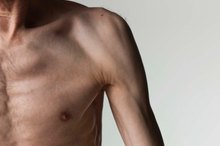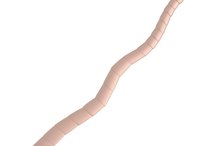Swollen Stomachs in Malnutrition
Malnutrition occurs when the body does not get the nutrients it needs to sustain health and normal development. Nearly one billion people worldwide suffer from malnutrition, according to the United Nations World Food Program. Many of the malnourished are children. The symptoms of malnutrition are many and may vary based on the type of malnutrition. The swollen or bloated stomach is a symptom of malnutrition and, specifically, is listed as a symptom of kwashiorkor.
Malnutrition
Although malnourished people with swollen stomachs are familiar representations of underdeveloped countries, malnutrition occurs in every country. The causes of malnutrition include poor diet and medical conditions, such as digestive problems. A mild case of malnutrition might not cause symptoms. A severe case of malnutrition can result in serious diseases, permanent damage to the body and death. Starvation is one form of malnutrition. Malnutrition can result from the lack of one nutrient, such as vitamin A or iron. Kwashiorkor is a form of malnutrition caused by protein-deficient diets.
Kwashiorkor
Does a Lack of Protein Cause Leg Edema?
Learn More
Kwashiorkor results from a lack of protein in the diet and is found most often in countries affected by poverty, famine, inadequate food supply and lack of knowledge about proper diet. In poor countries, kwashiorkor often happens during natural disaster or political unrest. In the United States, kwashiorkor rarely occurs in children except as the result of severe neglect and child abuse. The symptoms of kwashiorkor include skin pigment changes, fatigue, decreased muscle mass, failure to thrive, diarrhea, lethargy, rash, swelling, enlarged liver and protruding belly. Late stage kwashiorkor can cause shock. The condition can cause permanent mental, physical and development changes.
Swelling
The swollen belly that is a kwashiorkor symptom is common in children with the condition. Unlike other types of malnutrition, children with kwashiorkor can appear to be full or overfed because of the distended stomach. Children with kwashiorkor develop nutritional edema, which is swelling caused by fluid collecting in and around tissues, mostly affecting the legs and abdomen. Micronutrient deficiency, especially nutrients with anti-oxidants, might be an additional cause of the swelling, according to Mother and Child Nutrition.
Diagnosis, Treatment and Prevention
What Are the Signs & Symptoms of Malnutrition
Learn More
Doctors diagnose kwashiorkor by performing a physical examination, urinalysis and blood tests. If started early, increasing the calories and protein in the patient’s diet can correct the deficiencies. Patients slowly begin to eat a controlled diet and are given mineral and vitamin supplements. Severe cases of kwashiorkor may require more extensive treatment. A well-balanced diet that provides a variety of nutrients aids in the prevention of most types of malnutrition. Kwashiorkor can be prevented with a daily diet that includes carbohydrates, at least 10 percent of the total calories in fats and 12 percent of the total calories in proteins, according to the National Institutes of Health.
Related Articles
References
Writer Bio
Gail Sessoms, a grant writer and nonprofit consultant, writes about nonprofit, small business and personal finance issues. She volunteers as a court-appointed child advocate, has a background in social services and writes about issues important to families. Sessoms holds a Bachelor of Arts degree in liberal studies.









